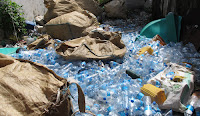‘People, Profit, Planet’,
or 3Ps, are the yardsticks by which modern designers draw on their sketchbooks
if they design products, services or systems for the sake of sustainable
development in which everybody in the (derelict) community
shares the benefits of their innovation. In the interest of global well-being,
this is arguably the course for the design industry in the new era because its
potential to contribute to the UN’s Millennium Development Goals is immense. Be it, regrettably, yet to
become a norm for the entire industry because leading voices on sustainable
design are lacking, as Seymourpowell’s
Chris Sherwin indicates in his recent article.
Indeed are such voices really lacking or simply not penetrating enough?
Work which links ‘design’
and ‘development’ has already been underway since the mid-noughties. ‘Design
for Sustainability’ (D4S), a joint effort by UNIDO and UNEP, has become a
dynamic voice for sustainable design in the new century. Since 1990s when
concepts like ‘Ecodesign’ and ‘Design for the Environment (DfE)’ were
introduced, the global trend of product design has indisputably dashed towards
environmentalism. D4S goes beyond how to make a ‘green’ product and embraces
how best to incorporate social factors into long-term product innovation
strategy throughout the life cycle of the product, throughout the supply chain,
and with respect to their socio-economic surroundings (from local community for
an SME to the global market for a transnational company). Concerns for poverty
eradication and rapid environmental degradation underline the potential in
developing economies for integrating D4S into product or business development.
Then, some ‘stylists’ may
ask, why on earth do designers need to take developers ’responsibilities on
their own shoulders? This brings
us back to the fundamental question that
what design is actually about. “Design is
the management of constraints”, summarised Dino Dini, a games designer.
Today, companies create new products or services considering constantly the
constraints associated with ‘profit’ and; increasingly those with ‘planet’
throughout the product’s life cycle, which is due to the need of regulatory
compliance, cost saving, defending or expanding market share through green
marketing and/or pressure from dedicated environmental groups. What in-house
experts should put more emphasis on is ‘people’ – the social dimension of
sustainability.
The importance of product
innovation is rapidly growing in developing countries. The social aspect of a
sustainable product supply chain encompasses
local economic growth, community development and stakeholder engagement. In
brief, the pivotal idea is
that a company should aim to share benefits from its investment with local small-scale businesses or provide tools
for economic growth to local communities. In the context of D4S, such
investment can be a newly designed product or system sufficiently practical to
enable the extensive provision of affordable essential services (e.g. energy,
health, education, water and sanitation) to the community at large and hence, uphold the human rights of the
underprivileged or indigenous people.
I would like to illustrate this view with an example which demonstrates
how new product development can enhance quality of life, generate regional assets, maximise social capital and
at the same time protect the environment of the entire community. On Zanzibar
Island, Tanzania, with donations from Swedish Government, a company was to
utilise recycled plastic material as a basis for development of a new,
sustainable product – functional school furniture, made partially or fully from
recycled plastics. This design concept has given rise to the implementation of a locally adapted, commercially driven
recycling and plastic waste management system which generates maximum social
and environmental impacts. Up to this year, the end-to-end collection system
has handled and recycled around 500 tons of plastic locally, while creating 2,000 full-time employment opportunities. Up
to 100 people are employed at the processing plant. To the company’s benefit,
on top of ‘free advertisement’, the knowledge acquired about local market and its environment, and other important
considerations such as ergonomics, several demands and requirements for the
school furniture defined has further facilitated their product development. In
other words, the new design concept has become a catalyst for long-term change
towards a cleaner, richer and more sustainable Zanzibar .
Sustainable development
for the poor is not non-achievable without high-level technology transfer. A new concept for product
design can make a big difference as it vitalises a number of sectors in a local
economy. So I cannot agree more that the way things are designed could have
significant implications for sustainability, as Sherwin suggests. Now we have
more than enough professional designers who are excellent stylists and
fashionistas, but what we need much more is a group of socially conscious designers
who can help revolutionise such mentality of design and push sustainability to
the mainstream, with their creativity and entrepreneurship that can deliver practical
solutions to overcome developmental
barriers in less developed countries.
To achieve shared
prosperity on our planet, we should reckon on this group of ‘angels’ who can ‘leapfrog’
developing countries over the resource-intensive development path that have
been followed by developed countries. Of course, more needs to be done if D4S
is to be a ‘leading’ voice for sustainable design.
Email me at winstonkm.mark@googlemail.com


No comments:
Post a Comment